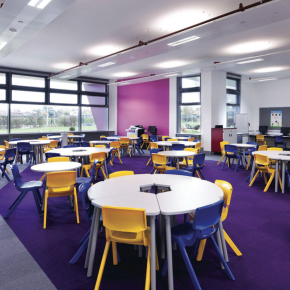
Improving education by creating fit-for-purpose buildings
With an increased demand for school places following a UK population growth spurt, Andrew Sykes, managing director of education flooring provider, Heckmondwike FB, explains how good building design and the specification of durable materials can future-proof schools and even improve staff retention and productivity, in the latest issue of ABC+D magazine.
According to the Office for National Statistics (ONS), the UK population is projected to rise by 9.7 million by 2039.
What impact will this increase have on education quality and provision? It is estimated that the number of primary and secondary school pupils will increase by an additional 729,000 by 2020. To cope with this influx, more than 2,000 new schools (24,000 classrooms) must be built in England during the same period.
The rise in pupil numbers will require more teachers to sustain a high quality of learning. However, the latest figures from the Institute for Fiscal Studies show that 40% of those who enter initial teacher training were not teaching five years later. This equates to 14,000 new teachers leaving the classroom each year.
A growing shortage of teachers and problems with retention means that future education provision and, ultimately, quality, will suffer as there will be less qualified teachers available to teach, especially core subjects such as Maths, Science and English.
Teacher shortages in 2014/15 led to the cost of agency supply teachers to increase by £50m compared to the previous two years. Stress and overcrowding brought about by poor learning environments have been cited as one of the reasons teaching staff leave the profession.
However, research by RIBA, as well as Arup’s Building Use Survey Methodology Database, shows that good school design and comfort increases staff productivity, which delivers higher school outcomes. In fact, well designed schools demonstrated a 15% increase.

“Teacher shortages in 2014/15 led to the cost of agency supply teachers to increase by £50m compared to the previous two years” Andrew Sykes Heckmondwike FB
To meet the impending demand, there needs to be a drastic re-think by Government and local authorities to ensure there are enough school places and teachers to maintain quality levels Standardised design (in the form of processes, dimensional co-ordination of buildings, components, assemblies and modules), classroom extensions and larger super-schools have been touted as possible options to deliver fit for purpose school checks.
At present, around £150m is spent annually on unnecessary services and maintenance, which would otherwise be avoided through better school design.
Investing in quality school building and utilising the avoidable cost savings to train, employ and retain more teachers will be crucial if the Government is to meet future demand. However, it is important to note that, just like the housing crisis, the shortage of schools is primarily a supply-side issue and, without extra capacity, things will not get better.
When considering products and materials to facilitate quality school building, elements such as durability, comfort and performance must be at the forefront of the specification process. An often overlooked component in this regard is flooring. Here, heavy footfall and a susceptibility to stains and dirt requires a robust flooring solution.
Fibre bonded carpets are suitable as they are stain resistant, withstand heavy wear- and-tear and also act as an interceptor, protecting floors from shoe-borne dirt and moisture.
The best flooring solutions can help meet good interior design criteria by offering a range of colours and textures which can be combined to achieve bespoke spaces and create distinct, flexible areas. When combined with other classroom components, such as furniture, flooring can help contribute to higher engagement thanks to better overall design.
Good school design is defined in the RIBA Top Marks School Report as simple, natural ventilation systems, optimum amount of colour in learning spaces, quality natural and artificial lighting, acoustics and flexible spaces. An optimum level of visual interest in terms of design and giving pupils a sense of ownership are also proven to be factors for a successful school building i.e. dedicated social or self-directed learning spaces, child-centred furniture and imagery the pupils can relate to.
Focusing budgets on well-designed and durable buildings saves money, improves staff performance and aids retention, all of which improves pupil outcomes.
Latest news

24th April 2024
The lowdown on Origin’s New Soho Offering
Origin’s Soho External Door is the first launch in its new generation of products, setting a higher standard for the fenestration industry.
Posted in Access Control & Door Entry Systems, Aluminium Products, Architectural Ironmongery, Articles, Building Industry News, Building Products & Structures, Building Systems, Doors, Innovations & New Products, Posts, Restoration & Refurbishment, Retrofit & Renovation, Security and Fire Protection
24th April 2024
Mitsubishi Electric welcomes new code of conduct for smart appliances
Mitsubishi Electric welcomes a new code of conduct on energy smart appliances which the European Union (EU) announced yesterday at the Hannover Fair in Germany.
Posted in Air Conditioning, Articles, Building Industry Events, Building Industry News, Building Products & Structures, Building Regulations & Accreditations, Building Services, Exhibitions and Conferences, Facility Management & Building Services, Heating Systems, Controls and Management, Heating, Ventilation and Air Conditioning - HVAC, Plumbing, Retrofit & Renovation, Seminars, Sustainability & Energy Efficiency
24th April 2024
Hamworthy Heating expands CIBSE approved CPD modules with new hot water series
Hamworthy Heating, technical experts in commercial heating and hot water products, announce the expansion of its market leading CIBSE approved Continuing Professional Development (CPD) portfolio with the launch of three new learning modules.
Posted in Articles, Building Industry Events, Building Industry News, Building Products & Structures, Building Services, Continuing Professional Development (CPD's), Facility Management & Building Services, Heating Systems, Controls and Management, Heating, Ventilation and Air Conditioning - HVAC, Plumbing, Retrofit & Renovation, Seminars, Training
24th April 2024
New technology partnership brings Passivent ventilation products to IESVE
Passivent has partnered with Integrated Environmental Solutions (IES) to make a number of its products available to model within the Virtual Environment (VE) platform IESVE.
Posted in Air Conditioning, Articles, Building Industry News, Building Products & Structures, Building Services, Facility Management & Building Services, Heating, Ventilation and Air Conditioning - HVAC, Information Technology, Innovations & New Products, Posts, Retrofit & Renovation, Roofs, Ventilation
 Sign up:
Sign up: